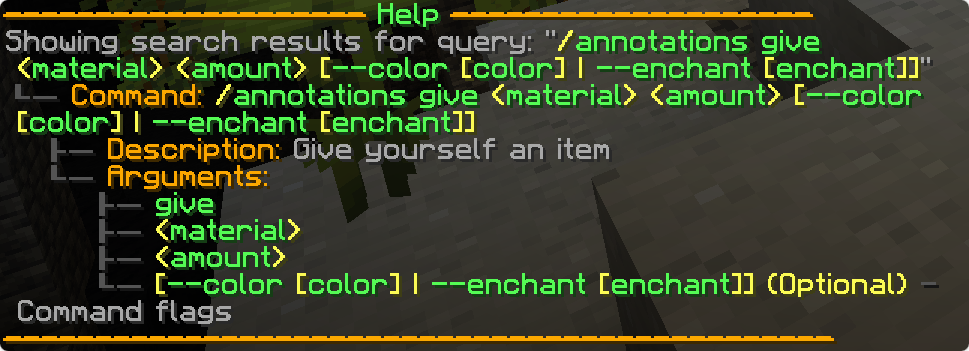cloud-minecraft-extras#
cloud-minecraft-extras contains some optional utilities for the Minecraft integrations.
Note
These utilities depend on adventure. You may need to depend on Adventure and shade it into your project, depending on the platform you’re targeting. Many Minecraft platforms, such as Paper, ship with native implementations of Adventure, in which case you do not need to include it yourself.
Installation#
Cloud Minecraft Extras is available through Maven Central.
<dependencies>
<dependency>
<groupId>org.incendo</groupId>
<artifactId>cloud-minecraft-extras</artifactId>
<version>2.0.0-beta.2</version>
</dependency>
</dependencies>
implementation("org.incendo:cloud-minecraft-extras:2.0.0-beta.2")
implementation 'org.incendo:cloud-minecraft-extras:2.0.0-beta.2'
Minecraft Help#
MinecraftHelp is an opinionated implementation of the help system using
Adventure components for styling and click handling.


All interactions with the Minecraft help system will take place through a MinecraftHelp instance.
You may create an instance with the default styling:
// Assuming YourSenderType extends Audience
MinecraftHelp<YourSenderType> help = MinecraftHelp.createNative(
"/helpcommand",
commandManager
);
MinecraftHelp<YourSenderType> help = MinecraftHelp.create(
"/helpcommand",
commandManager,
audienceMapper // YourSenderType -> Audience
);
or you may override the defaults by using a builder:
MinecraftHelp<NativeSenderType> help = MinecraftHelp.<NativeSenderType>builder()
.commandManager(commandManager)
.audienceProvider(AudienceProvider.nativeAudience())
.commandPrefix("/helpcommand")
.colors(MinecraftHelp.helpColors(NamedTextColor.GREEN, NamedTextColor.RED,
NamedTextColor.AQUA, NamedTextColor.BLACK, NamedTextColor.WHITE
))
/* other settings... */
.build();
AudienceProvider<SenderType> audienceProvider = SenderType::audience;
MinecraftHelp<SenderType> help = MinecraftHelp.<SenderType>builder()
.commandManager(commandManager)
.audienceProvider(audienceProvider)
.commandPrefix("/helpcommand")
.colors(MinecraftHelp.helpColors(NamedTextColor.GREEN, NamedTextColor.RED,
NamedTextColor.AQUA, NamedTextColor.BLACK, NamedTextColor.WHITE
))
/* other settings... */
.build();
You then want to invoke MinecraftHelp.queryCommands(query, recipient) in order to query the commands
and display the results to the recipient.
commandManager.command(
commandManager.commandBuilder("helpcommand")
.optional("query", greedyStringParser(), DefaultValue.constant(""))
.handler(context -> {
help.queryCommands(context.get("query"), context.sender());
})
);
You may choose to add suggestions to the query argument as well:
.optional(
"query",
greedyStringParser(),
DefaultValue.constant(""),
SuggestionProvider.blocking((ctx, in) -> commandManager.createHelpHandler()
.queryRootIndex(ctx.sender())
.entries()
.stream()
.map(CommandEntry::syntax)
.map(Suggestion::simple)
.collect(Collectors.toList())
)
)
Minecraft Exception Handler#
MinecraftExceptionHandler is an opinionated collection of exception handlers
that uses Adventure components for styling.
All interactions with the system are done through an instance of MinecraftExceptionHandler.
// Assuming your sender type extends Audience
MinecraftExceptionHandler.createNative();
MinecraftExceptionHandler.create(audienceProvider // C -> Audience);
You then use the fluent methods to create handlers for the different exception types.
If you want to register the default handlers for all types you may use defaultHandlers().
You may supply a decorator which will transform the created components. This is useful if you want to prefix all messages, or apply specific styling.
MinecraftExceptionHandler.createNative()
.decorator(component -> text()
.append(text("[Example] ", NamedTextColor.DARK_RED))
.append(component)
.build()
);
When you’re done configuring the builder you need to apply it to the command manager by using
registerTo(CommandManager).
MinecraftExceptionHandler.<NativeSenderType>createNative()
.defaultHandlers()
.decorator(component -> text()
.append(text("[Example] ", NamedTextColor.DARK_RED))
.append(component)
.build()
).registerTo(manager);
Localization#
MinecraftExceptionHandler uses the localization system. By default, the exception
handler will make use of a
ComponentCaptionFormatter
that wraps the caption value in a text component.
You may choose to replace the caption formatter with a component formatter that uses MiniMessage by using
ComponentCaptionFormatter.miniMessage().
MiniMessage will then be used for both styling and placeholder replacements.
Rich Description#
RichDescription allows for the use of Adventure components in both component and command descriptions.
These descriptions are supported by MinecraftHelp. If descriptions are used in other places
they are likely to be transformed into plain text.
// Static factory:
Description description = RichDescription.of(text("Hello world!"));
// Statically importable alias:
Description description = RichDescription.richDescription(text("Hello world!"));
// Utility for translatable components:
Description description = RichDescription.translatable("some.key", text("an arg"));
Text Color Parser#
TextColorParser is a parser which parses Adventure TextColors.
It parses NamedTextColor, legacy color codes using & as well as hex codes.
ParserDescriptor<?, TextColor> parser = TextColorParser.textColorParser();